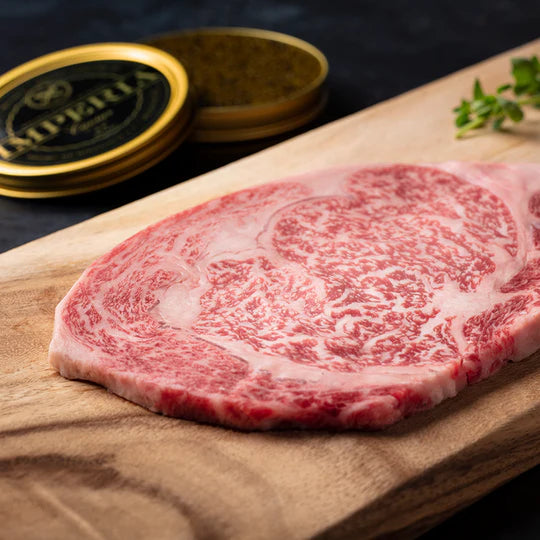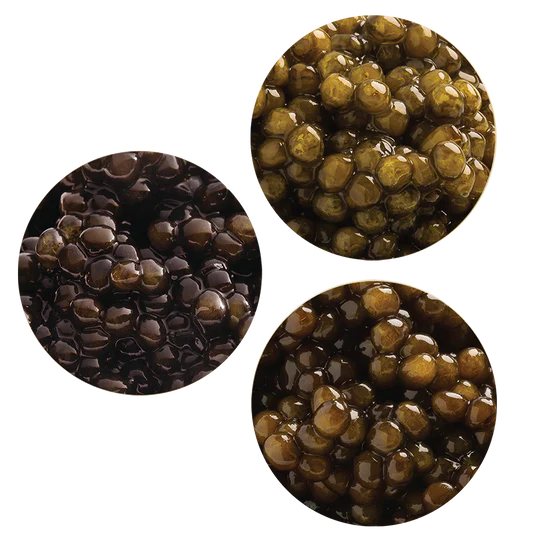
So you’ve taken the plunge and laid down the money for some fine caviar, but you want to know how to care for your investment and make sure those flavors last. The truth is that caviar doesn’t last forever, but you can do a lot to make sure you get the most mileage out of each gram.
Let’s examine how long caviar is meant to last and the steps you can take to improve its shelf life without diminishing quality.
How to Store Caviar
Because caviar is highly delicate and perishable, you should handle this culinary gem with the utmost care. To maintain optimal quality and freshness, here are some tips to keep in mind when storing caviar:
- Caviar is best stored at cold temperatures — refrigerate the tin at a temperature range of 28 to 32 degrees Fahrenheit.
- If you're serving caviar and leaving it out — like for a buffet or party — keep it in the original caviar container in a bowl of crushed ice.
- Remove the caviar from the fridge roughly 10 to 15 minutes before serving it.
- Fresh unpasteurized caviar can be kept unopened in the fridge for up to four weeks.
- Once you open the caviar, try to eat it within 48 hours.
When you order a tin of caviar, read the label carefully once your product arrives. This should include storage and shelf life information.

How Long Does Caviar Last?
All eggs eventually go bad, and caviar is no exception. Multiple factors influence caviar shelf life, such as storage temperature, preservative content and the type and quality of packaging. Caviar is a delicious delicacy, so it shouldn't go to waste simply because of how you store it. Let's look at how long caviar lasts based on different storage techniques.
1. Refrigerated
If kept in an unopened vacuum-sealed container in a household refrigerator, most caviars last four to six weeks. It should be stored just around freezing point but not fully frozen. Anywhere between 28 and 32 degrees is ideal, so determine the coldest area of your refrigerator and designate it as your caviar storage spot. While some varieties may last longer than others, most will start to go bad after a month.
Imperia Caviar's refrigerated shelf life is three weeks. This is shorter than other caviars on the market because we don't use unsafe and unpleasant preservatives, such as borax. We offer Malossol caviar, which contains less salt than most caviars.
Our caviar is best consumed as quickly as possible. We receive our fresh caviar directly from our farms, pack it to each specific order and ship it out quickly. All of this allows us to provide you with the freshest and finest caviar on the market.
Shop High-Quality Imperia Caviar
2. Room Temperature
Remember that air fosters the perfect environment for harmful bacteria to grow. Try to limit your caviar's air exposure as much as possible. When left unrefrigerated, caviar can start to spoil after about two hours. If the serving area is 90 degrees or above, it can start to go bad after one hour.
3. Frozen
It's not recommended to store caviar in the freezer, as this impacts the texture of most varieties. If you do freeze caviar, an unopened container can last up to a year, whether it's pasteurized or not. However, once you open the container it can start to dry out from air contamination, losing its quality and flavor within a week.
Ideal Conditions for Longevity
Now that you have an understanding of basic storage techniques and how long caviar lasts in certain conditions, let’s go over some additional storage tips to increase longevity.
1. Store It Immediately
If you order from a reputable producer, your caviar will arrive secured in dry ice or another type of cold packaging to ensure freshness. Don’t let it sit outside in the heat any longer than necessary — the caviar should immediately be taken out of the box and moved to the fridge.
Any leftover caviar should be secured in plastic wrap and stored in the same place, but don’t forget about it! Make sure you finish off the jar within a day or two.
2. Use the Bottom Drawer
For some folks, the freezer is the only ice-cold option for caviar storage. Although, sometimes the refrigerator's bottom drawer or the very bottom, back part of the fridge can preserve optimal quality by protecting it from temperature changes. You could also store unopened pasteurized caviar tins in small bowls of ice or over an ice pack in the back of the fridge.
3. Only Freeze Certain Varieties
Freezing caviar may be fine for bowfin or hackleback. However, when storing more expensive varieties like Ossetra or Sevruga, we recommend normal refrigeration to minimize the loss in quality and to maintain its firm texture.
Maintain Quality When Serving
Proper caviar serving begins as soon as you take the container out of the refrigerator. A common mistake is to simply pop it open and dig in. Instead, you’ll want to let the caviar sit at room temperature for about 10 minutes before opening the container to let the eggs settle and separate from one another.
From here, you can put the container on ice and serve or move it to a separate cold vessel. Proper dishware and implements are key here and help ensure the caviar keeps 100% of its quality while serving and scooping.
Avoid having your caviar come into contact with metal spoons, bowls or anything made of this material. It can compromise the taste of your caviar and cause surface damage to your kitchenware via oxidative reactions from the eggs. If you are planning to make caviar a regular part of your routine, it’s worth purchasing a designated glass bowl set and some mother-of-pearl spoons to make the most of your investment.
Whether you prepare it as a garnish or as the main event, make sure you serve your caviar properly to maintain that flavor and texture in every bite. Popular accompaniments include blinis, toast, sour cream, unsalted crackers, champagne and vodka.
Finally, don’t let your caviar sit out too long while you’re chatting with guests and making the rounds. The caviar should be the main focus of the moment to ensure everyone gets a taste at its peak.
Why Caviar Is Cured
“Cured sturgeon roe” is the purest definition of caviar. Cured means salted in a way that preserves the eggs for longer than possible in nature.
It can be cured heavily or lightly depending on the eggs’ quality, but at least a little bit of salt is necessary for the food to be classified as caviar. While sustainable farming and production methods have advanced quickly in the 21st century, the process of curing sturgeon roe remains fairly simple.
Once the eggs are separated from the membranes and all impurities are removed, the eggs are washed and prepped to be cured. From there, the producers will submerge the eggs in a saline solution. For premium sturgeon caviar like Beluga, Ossetra, and Sevruga, producers typically aim for the total salt content to be less than 3.5%, earning the label “malossol” or “little salt.”
Larger batches of commercial caviar can contain salt content anywhere between 5% and 9%, although most producers avoid going over the 10% mark in most circumstances.
When manufacturing “payusnaya” pressed caviar products and caviar paste, the salt content is generally over 10% to ensure structure and preservation. As a result, these products have longer shelf lives and remain edible for weeks after opening.
While the curing process does help to preserve the caviar for longer than most seafood and bring out some flavor, this is still a highly perishable product that should be consumed sooner rather than later.
Malossol caviars should remain in the fridge no longer than four weeks before opening and enjoying, and even saltier varieties tend to taste better earlier on. When properly stored, an unopened container lasts up to 15 months in some cases.
Once that container is opened, it is best to consume it all within less than 48 hours.
Pasteurized or Unpasteurized?
The pasteurization process is widespread in the world of canned and tinned foods. It involves lightly cooking the caviar to extend its shelf life. This doesn’t mean the caviar loses all of its charms, but you will notice that these products don't always have the same “pop” and freshness of flavor as traditional varieties like malossol.
The upside of pasteurized caviar is that you can keep an unopened container on the shelf for up to a year without worrying about further degradation. However, once you do pop the seal, you should treat the pasteurized caviar the same way you would caviar — consume it that day or within 48 hours if possible.
While it’s rare to see pasteurized caviar labeled as such, you can usually tell by the way it is packaged. Vacuum-sealed containers typically indicate that the product has been pasteurized, but you can ask a trusted merchant or consult online to determine for sure.
Some connoisseurs may look down their noses at pasteurized caviar, but these are entry-level products that have their appropriate time and place. They are great for use in larger quantities to make pasta and more complex dishes, where larger tins of high-grade caviar would be considered a wasteful use of expensive food.
With that said, the finest caviars are unpasteurized and meant to be consumed quickly after packaging to ensure maximum freshness and flavor.
Preservatives in Caviar
It's also important to note that many sturgeon eggs are treated with food preservatives during the production process. The intent is to extend the caviar's shelf life and enhance flavor. Traditionally, the most common caviar preservative was sodium tetraborate, or borax. Some production facilities still use this preservative today.
However, borax isn't always safe to ingest. It can cause side effects like vomiting, nausea, shock and even kidney failure, especially when consumed in large amounts. It can also irritate the eyes, skin, nose, throat and lungs when you breathe it in. For these reasons, it's banned in U.S. food products.
Imperia Caviar products are completely preservative-free, so you can enjoy the delicious flavor and quality of our premium caviar with added peace of mind.
Practice Proper Storage With Your Own Caviar
When it comes to making the most of your caviar investment, there are many factors in your control. If you follow the tips we’ve talked about in this article, your caviar will last longer than you thought possible!
At Imperia Caviar, we understand the importance of good storage practices — not to mention investing in premium affordable caviar. When you purchase fresh caviar from our online store, you'll experience outstanding flavors, a variety of health benefits and an unforgettable culinary experience that will have you finishing the tin in no time. Browse our quality caviar selection and order yours today, then follow the above recommendations to extend its freshness!
Have any other questions about proper storage or caviar in general? Get in touch with us through our FAQ page!
Last Updated 8/18/22




